Celebrating the Winter Solstice with Sacred Foods and Feasting
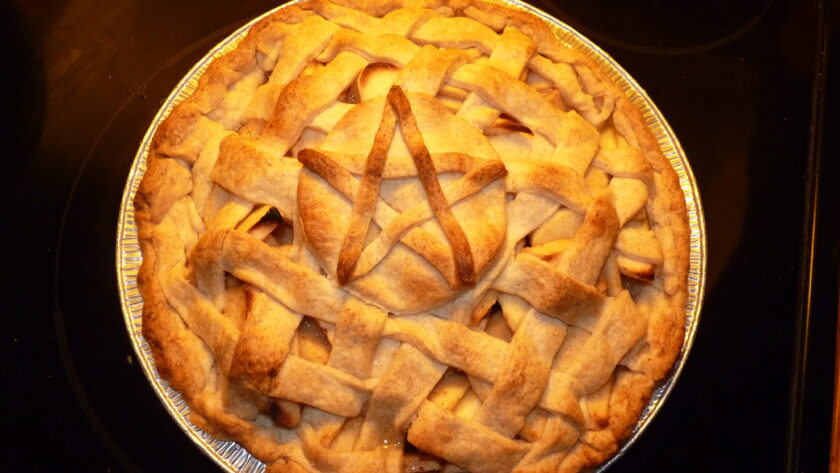
 Dana
Dana
The Winter Solstice has long been a time of feasting and fires, especially with regional and special foods, a tradition that has global significance in many cultures. I’ve always enjoyed this time as a chance to dig into some really interesting sacred cooking and bring back the light by enjoying foods that were preserved in the lighter times. As I’ve grown deeper into my own druid practice, I’ve recognized the importance of bringing in the sacred to everyday life (which is what I discuss in my book Sacred Actions: Living the Wheel of the Year through Earth-Centered Sustainable Practices). Thus, thinking about sacred cooking, special recipes, and seasonal foods has become a critical part of how I celebrate the wheel of the year. In today’s post, we’ll explore an emphasis on sacred cooking and feasting traditions, with an emphasis on the current season at the Winter Solstice. Hopefully, this will generate some new ideas for how to lovingly prepare foods, feast, and make merry this wonderful time of year.
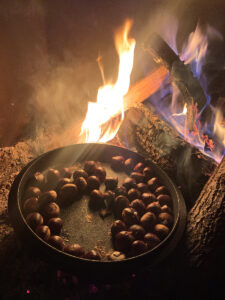
Chestnuts roasting on the open fire at Yule
The Winter Solstice is a global phenomenon, occurring generally sometime between December 20-23 in the Northern Hemisphere and June 20-23 in the Southern Hemisphere. Many cultures all over the world celebrate the darkest day of the year with fires, rituals, and feasting.
Ancient Rome’s festivals of Saturnalia and Sol Invictus involved much feasting this time of year. Saturnalia, an ancient Roman holiday of feasting, took place December 17th with festivities up until Dec 23rd. The time of Saturnalia involved role reversals, feasting, gambling, gift-giving, and of course today, many pagans, particularly Hellenistic pagans, still celebrate the event. A related holiday, the celebration of the Sun God, Sol Invictus (Helios), was celebrated on December 25th, the “dies natalis Invicti” which refers to the rebirth of the sun. It’s not a stretch to see how these days of feasting in Ancient Rome were appropriated into the modern 12 days of Christmas and Christmas day.
Beyond Rome, we see Dong Zhi, the “arrival of winter” festival in China, which also typically falls between Dec 21st and 23rd. Its origins were also as an end-of-the-harvest year festival, where families would gather to enjoy the fruits of the harvest with special foods. In Scandinavia, “St. Lucia’s Day” is another modern feasting and fire festival that was likely appropriated from older Norse solstice traditions. In Peru, another sun god festival, Inti Raymi, takes place. Celebrated in June at the winter solstice in the southern hemisphere, the festival included feasting and sacrifices to the sun God. Yet another festival is Yalda (or Shab-e Yalda), which is a celebration of the winter solstice in Iran, celebrating the birthday of the sun god Mithra. This festival often included special red-colored foods like pomegranates, beets, and watermelon, and also often included vigils to welcome the morning sun.

Cinnamon Rolls for a feast!
More modern notions of Christmas, including the 12 days of Christmas, were as pragmatic as they were celebratory in the times before industrialization. As most people were substance farmers, ensuring that the harvest was not going to go to waste was critical. In Northern, colder climates, the last of the harvest was brought in–possibly 1-2 months before the winter solstice–and many of the short-term storage foods were starting to be at the end of their shelf life. Further, with the coldest and darkest months ahead, animal herds need to be thinned, and the resulting animals eaten and feasted upon. Thus, Christmas and the 12 days of feasting as a tradition was also rooted in the idea that the foods needed to be eaten and feasted upon before the dark, hungry times were upon them. It was better to carry the calories on your body than have them rot unused in a cellar or attic. Thus, cooking the feasts and fattening up was a survival strategy.
What we can see from this list–and it is hardly exhaustive–is that winter solstice celebrations often have two common elements: an honoring of the sun, sun god, return of the sun, and/or fire, and the concept of sacred feasting.

Acorn bread, one of my favorite Winter Solstice foods.
History and cultural traditions. This is obviously a great place to start–look at cultural traditions for the pagan tradition you practice and see what you can adapt. The problem with many pagan traditions is that we have broken lineages, so questions like “what would the ancient druids have eaten as part of a sacred winter solstice feast” generally cannot be answered–although I can certainly answer that question more broadly about Celtic culture, as records exist. Thus, you might be able to learn to make some cultural foods associated with these holidays. For example, if you wanted to root some of your traditions in Saturnalia, you might start with the book Around the Roman Table: Food and Feasting in Ancient Rome (Patrick Faas) and learn how to cook traditional Roman festival dishes. Another fun book with global traditional recipes is Tasting History: Explore the Past through 4000 years of Recipes. There are a lot of great resources like this.
Wild Food Foraging and sacred foods. My own take on it, as a druid practicing locally-based, wildcrafted druidry, is to look to the traditional foods of my own region, particularly, what grows here natively. You can ask: What was recently harvested? What is available? What can I preserve in the light half of the year to enjoy in the dark half of the year? For me, a good deal of my own exploration is around hardwood nut harvests, working with oak and how to create acorn bread, chestnut, walnut, and hazelnut. The preparation of acorns, as my link shares, is quite long and drawn out, but worth the beautiful purple-brown of your cakes, breads, and scones that you can make from the flour. Chestnuts do roast wonderfully over an open fire, and hazelnut and walnut can accompany many dishes. Other foraged foods I like to build in are anything that is in season–various berries and greens, roots, and so forth. If you will be foraging as part of your sacred practice, please also see my foraging ethics.

Pizza from the earth oven
Cooking methods. Special cooking methods can take time but be another important part of how to cook special, ritual foods. Ancient methods of cooking are usually fire-based and may use an open fire or hearth cooking, earthen ovens, fire pits, and other direct fire-based methods. Other traditional cooking methods may include clay pots or other special tools. For learning a bit about fire cooking, I really appreciate Eat Like a Viiking: A Guide to Anglo-Saxon and Viking Age food and Drink (which assumes you are cooking over a fire) and also Cooking with Fire by Paula Marcoux (which is a more modern book).
For us, we do a lot of baking and wanted a chance to be more sustainable in our use of electricity. So over the last two years, we created an earth oven out of all local materials and we use that to do day-long baking for ritual feasts. You can learn more about this here: baking in your earth oven, preparing the land for the earth oven build, earth oven build post 1, earth oven build post 2. We are continuing to build this outdoor cooking and hosting space for rituals, feasts, and ceremonies.
Growing your own or getting in season and preserving the harvest. Of course, all food traditions are rooted in what grows locally and what is available. Thus, if you are able to grow and preserve any of your own harvests, or eat locally from a farmer’s market, this is another way for you to be inspired and build local food practices.
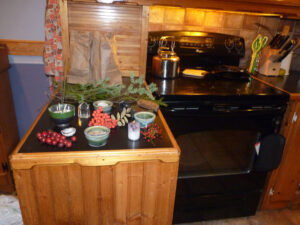
Sample kitchen altar
Cooking with Ceremony: Creating a ceremony around your cooking is one way of bringing in sacredness. Even if you aren’t cooking a special food or an ancestral dish, just cooking it in a sacred way can add some magic to the experience. To cook with ceremony, you can be as formal or informal as you wish. My own technique is typically to open a sacred space (in my case, a Sacred Grove using AODA’s solitary grove ritual). I usually set up a small altar somewhere in the kitchen (on one of the counters) and open the space. Then I go about my cooking, adding intention, chanting, and prayers as I work. You can develop your own method–the key here is to find ways of bridging the physical act of cooking with the metaphysical act of spirit.
Meal as an Offering. Gratitude and making offerings back to the land that has provided the food for the meal is another important way to build in sacredness. This can be in the form of a spirit plate (where a small portion of the meal is offered to spirits on a small plate; the plates can be left outdoors or given to wildlife). Or you can make any other kind of offering you see fit–adding an offering as part of the harvest and the meal is an important way to honor that which has been given and foster deep gratitude.
Cooking with Special Tools: Grandma’s special baking dish, your mom’s wooden spoon, a specially crafted cast iron kettle–just like we use rituals to help build in sacredness, we can also use special tools that only come out once in a while. These can also
Cooking with Symbols. Symbolism can be another way to elevate food to new levels. You can build symbols into your cooking, such as a spiral or pentacle into your pie, runes or ogham into your bread, a wheel for the wheel of the year, a full moon cake, and more. The sky is really the limit in terms of what you can do with cooking symbolism here.
Kitchen shrine. If you decide to take up the practice of cooking regularly, you can build a permanent shrine in or around your kitchen and dedicate that to sacred cooking, perhaps a feast-or food-oriented deity, etc. We have one such shrine in our home and I believe it really lends energy to our intention and our meals.
These ideas will hopefully encourage your own creativity–the point here is that you can experiment as you go, and figure out what works for you, based on your own path and gifts.
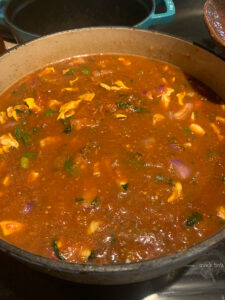
Tomato and vegetables, all preserved from the garden, and so delicious in the winter months
Once you begin to experiment with the idea of sacred cooking, eventually you can build a whole sacred food calendar, which can include ceremonial harvesting, offerings, and feasting. here I’ll share a sample local food calendar rooted in Western Pennsylvania (which is temperate and has four seasons, fairly consistent with the UK-based wheel of the year):
1. Winter Solstice: Acorn Bread (harvested from our local oaks in the fall); roasted chestnuts, roasted hazelnuts. These are typically baked in an earth oven and/or on our indoor hearth. Bread is usually served with a summer solstice or Lughnasadh-made jam (Autumn olive or Black Raspberry being my very favorite).
2. Imbolc: Cheesemaking with dairy from local farms (both goat cheese and cow milk cheese)
3. Spring Equinox: Maple Syrup (with a full breakfast for dinner–farm fresh eggs, crisp local and ethical bacon, and acorn pancakes). This whole meal is cooked outside as part of our maple sap boiling day, sometime near the Spring Equinox. Thus, it is tied both to the seasonal harvest (the maple syrup) and also the activity.
4. Beltane: Spring Nettle, Leek, and Spring Greens soup. These are early harvests on our land and can also be wild foraged from the local ecosystem. During this time of year, as is an Appalachian folk tradition, you can also enjoy a nice pot of dandelion tea, which is said to “thin the blood” and allow for the hard work of planting and activity that spring and summer bring.
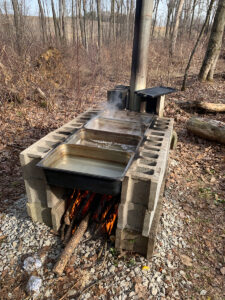
The Maple Sap Boiler!
5. Summer Solstice: At this point, the first of the summer harvests are coming in, so there are usually peas, lettuce and kale greens, zucchini, and summer squashes in abundance. We make stir fry, bread, muffins, and fritters with these wonderful and abundant vegetables from the garden.
6. Lughnasadh: Lughnasadh is the time of beans, more summer squash, celery, and other such garden delights. Wild summer mushrooms are often in great abundance. Pizzas from our earth oven can take advantage of these wonderful wild and homestead foods.
7. Fall Equinox: Apples are abundant in our ecosystems in the fall, and we make it a point to create a number of apple-themed dishes such as pies, homemade applesauce, and even start apple vinegar or ciders.
8. Samhain: Pumpkins, squash, and various root vegetables that were recently harvested form the basis of our seasonal foods at Samhain–especially pumpkin pie, pumpkin soup, and pumpkin bread. In the last few years, my partner has taken to stuffing pumpkins full of delicious things this time of year, and it is turning into a family tradition that everyone in the extended family appreciates. Another one at Samhain and into the winter solstice is Sassafras tea; which Appalacian folk traditions use to “thicken the blood” for the cold and dark times ahead.
This list above is very much rooted not only in the immediate landscape around where I live, but also in being a homesteader and participating in a number of seasonal activities like maple sugaring, growing and harvesting food, and foraging. Your own seasonal foods should reflect where you live and what you have access to.
I have a new article in Spirituality and Health Magazine on druid winter ritual practices.
Finally, I have started writing a regular column for Plant Healer Quarterly magazine. My new column will explore the metaphysical aspects of plant relationships in an herbalism practice. The new articles should be out in this upcoming magazine!
I wish you a blessed Yule season, Winter Solstice, Saturnalia, or any other feast and festival you celebrate!
THANKS TO: https://thedruidsgarden.com/2022/12/18/celebrating-the-winter-solstice-with-sacred-foods-and-feasting/

The Winter Solstice has long been a time of feasting and fires, especially with regional and special foods, a tradition that has global significance in many cultures. I’ve always enjoyed this time as a chance to dig into some really interesting sacred cooking and bring back the light by enjoying foods that were preserved in the lighter times. As I’ve grown deeper into my own druid practice, I’ve recognized the importance of bringing in the sacred to everyday life (which is what I discuss in my book Sacred Actions: Living the Wheel of the Year through Earth-Centered Sustainable Practices). Thus, thinking about sacred cooking, special recipes, and seasonal foods has become a critical part of how I celebrate the wheel of the year. In today’s post, we’ll explore an emphasis on sacred cooking and feasting traditions, with an emphasis on the current season at the Winter Solstice. Hopefully, this will generate some new ideas for how to lovingly prepare foods, feast, and make merry this wonderful time of year.
Winter Solstice Feasting Traditions

Chestnuts roasting on the open fire at Yule
The Winter Solstice is a global phenomenon, occurring generally sometime between December 20-23 in the Northern Hemisphere and June 20-23 in the Southern Hemisphere. Many cultures all over the world celebrate the darkest day of the year with fires, rituals, and feasting.
Ancient Rome’s festivals of Saturnalia and Sol Invictus involved much feasting this time of year. Saturnalia, an ancient Roman holiday of feasting, took place December 17th with festivities up until Dec 23rd. The time of Saturnalia involved role reversals, feasting, gambling, gift-giving, and of course today, many pagans, particularly Hellenistic pagans, still celebrate the event. A related holiday, the celebration of the Sun God, Sol Invictus (Helios), was celebrated on December 25th, the “dies natalis Invicti” which refers to the rebirth of the sun. It’s not a stretch to see how these days of feasting in Ancient Rome were appropriated into the modern 12 days of Christmas and Christmas day.
Beyond Rome, we see Dong Zhi, the “arrival of winter” festival in China, which also typically falls between Dec 21st and 23rd. Its origins were also as an end-of-the-harvest year festival, where families would gather to enjoy the fruits of the harvest with special foods. In Scandinavia, “St. Lucia’s Day” is another modern feasting and fire festival that was likely appropriated from older Norse solstice traditions. In Peru, another sun god festival, Inti Raymi, takes place. Celebrated in June at the winter solstice in the southern hemisphere, the festival included feasting and sacrifices to the sun God. Yet another festival is Yalda (or Shab-e Yalda), which is a celebration of the winter solstice in Iran, celebrating the birthday of the sun god Mithra. This festival often included special red-colored foods like pomegranates, beets, and watermelon, and also often included vigils to welcome the morning sun.

Cinnamon Rolls for a feast!
More modern notions of Christmas, including the 12 days of Christmas, were as pragmatic as they were celebratory in the times before industrialization. As most people were substance farmers, ensuring that the harvest was not going to go to waste was critical. In Northern, colder climates, the last of the harvest was brought in–possibly 1-2 months before the winter solstice–and many of the short-term storage foods were starting to be at the end of their shelf life. Further, with the coldest and darkest months ahead, animal herds need to be thinned, and the resulting animals eaten and feasted upon. Thus, Christmas and the 12 days of feasting as a tradition was also rooted in the idea that the foods needed to be eaten and feasted upon before the dark, hungry times were upon them. It was better to carry the calories on your body than have them rot unused in a cellar or attic. Thus, cooking the feasts and fattening up was a survival strategy.
What we can see from this list–and it is hardly exhaustive–is that winter solstice celebrations often have two common elements: an honoring of the sun, sun god, return of the sun, and/or fire, and the concept of sacred feasting.
Building Your Own Tradition: Sacred Feasting and Sacred Foods
What we can learn from these modern and historical holidays is that the concept of traditional ritual foods is critically important to the feasting, and as we seek to recover, rebuild, and reconstruct ancient pagan traditions, finding ways to build sacred feasting and ritual foods into our own practices and to those in our broader traditions is important. In order to create some sacred food traditions–there are a few places to look.
Acorn bread, one of my favorite Winter Solstice foods.
History and cultural traditions. This is obviously a great place to start–look at cultural traditions for the pagan tradition you practice and see what you can adapt. The problem with many pagan traditions is that we have broken lineages, so questions like “what would the ancient druids have eaten as part of a sacred winter solstice feast” generally cannot be answered–although I can certainly answer that question more broadly about Celtic culture, as records exist. Thus, you might be able to learn to make some cultural foods associated with these holidays. For example, if you wanted to root some of your traditions in Saturnalia, you might start with the book Around the Roman Table: Food and Feasting in Ancient Rome (Patrick Faas) and learn how to cook traditional Roman festival dishes. Another fun book with global traditional recipes is Tasting History: Explore the Past through 4000 years of Recipes. There are a lot of great resources like this.
Wild Food Foraging and sacred foods. My own take on it, as a druid practicing locally-based, wildcrafted druidry, is to look to the traditional foods of my own region, particularly, what grows here natively. You can ask: What was recently harvested? What is available? What can I preserve in the light half of the year to enjoy in the dark half of the year? For me, a good deal of my own exploration is around hardwood nut harvests, working with oak and how to create acorn bread, chestnut, walnut, and hazelnut. The preparation of acorns, as my link shares, is quite long and drawn out, but worth the beautiful purple-brown of your cakes, breads, and scones that you can make from the flour. Chestnuts do roast wonderfully over an open fire, and hazelnut and walnut can accompany many dishes. Other foraged foods I like to build in are anything that is in season–various berries and greens, roots, and so forth. If you will be foraging as part of your sacred practice, please also see my foraging ethics.

Pizza from the earth oven
Cooking methods. Special cooking methods can take time but be another important part of how to cook special, ritual foods. Ancient methods of cooking are usually fire-based and may use an open fire or hearth cooking, earthen ovens, fire pits, and other direct fire-based methods. Other traditional cooking methods may include clay pots or other special tools. For learning a bit about fire cooking, I really appreciate Eat Like a Viiking: A Guide to Anglo-Saxon and Viking Age food and Drink (which assumes you are cooking over a fire) and also Cooking with Fire by Paula Marcoux (which is a more modern book).
For us, we do a lot of baking and wanted a chance to be more sustainable in our use of electricity. So over the last two years, we created an earth oven out of all local materials and we use that to do day-long baking for ritual feasts. You can learn more about this here: baking in your earth oven, preparing the land for the earth oven build, earth oven build post 1, earth oven build post 2. We are continuing to build this outdoor cooking and hosting space for rituals, feasts, and ceremonies.
Growing your own or getting in season and preserving the harvest. Of course, all food traditions are rooted in what grows locally and what is available. Thus, if you are able to grow and preserve any of your own harvests, or eat locally from a farmer’s market, this is another way for you to be inspired and build local food practices.
Sacred Cooking Practices
Sacred cooking practices can both refer to the kind of method you use to cook your food (if it is something special or different) as well as setting up a sacred space/ritual space and engaging in other ceremonial activities for preservation, preparation, and cooking of your meals. Since I already covered
Sample kitchen altar
Cooking with Ceremony: Creating a ceremony around your cooking is one way of bringing in sacredness. Even if you aren’t cooking a special food or an ancestral dish, just cooking it in a sacred way can add some magic to the experience. To cook with ceremony, you can be as formal or informal as you wish. My own technique is typically to open a sacred space (in my case, a Sacred Grove using AODA’s solitary grove ritual). I usually set up a small altar somewhere in the kitchen (on one of the counters) and open the space. Then I go about my cooking, adding intention, chanting, and prayers as I work. You can develop your own method–the key here is to find ways of bridging the physical act of cooking with the metaphysical act of spirit.
Meal as an Offering. Gratitude and making offerings back to the land that has provided the food for the meal is another important way to build in sacredness. This can be in the form of a spirit plate (where a small portion of the meal is offered to spirits on a small plate; the plates can be left outdoors or given to wildlife). Or you can make any other kind of offering you see fit–adding an offering as part of the harvest and the meal is an important way to honor that which has been given and foster deep gratitude.
Cooking with Special Tools: Grandma’s special baking dish, your mom’s wooden spoon, a specially crafted cast iron kettle–just like we use rituals to help build in sacredness, we can also use special tools that only come out once in a while. These can also
Cooking with Symbols. Symbolism can be another way to elevate food to new levels. You can build symbols into your cooking, such as a spiral or pentacle into your pie, runes or ogham into your bread, a wheel for the wheel of the year, a full moon cake, and more. The sky is really the limit in terms of what you can do with cooking symbolism here.
Kitchen shrine. If you decide to take up the practice of cooking regularly, you can build a permanent shrine in or around your kitchen and dedicate that to sacred cooking, perhaps a feast-or food-oriented deity, etc. We have one such shrine in our home and I believe it really lends energy to our intention and our meals.
These ideas will hopefully encourage your own creativity–the point here is that you can experiment as you go, and figure out what works for you, based on your own path and gifts.
A Sample Sacred Food Calendar

Tomato and vegetables, all preserved from the garden, and so delicious in the winter months
Once you begin to experiment with the idea of sacred cooking, eventually you can build a whole sacred food calendar, which can include ceremonial harvesting, offerings, and feasting. here I’ll share a sample local food calendar rooted in Western Pennsylvania (which is temperate and has four seasons, fairly consistent with the UK-based wheel of the year):
1. Winter Solstice: Acorn Bread (harvested from our local oaks in the fall); roasted chestnuts, roasted hazelnuts. These are typically baked in an earth oven and/or on our indoor hearth. Bread is usually served with a summer solstice or Lughnasadh-made jam (Autumn olive or Black Raspberry being my very favorite).
2. Imbolc: Cheesemaking with dairy from local farms (both goat cheese and cow milk cheese)
3. Spring Equinox: Maple Syrup (with a full breakfast for dinner–farm fresh eggs, crisp local and ethical bacon, and acorn pancakes). This whole meal is cooked outside as part of our maple sap boiling day, sometime near the Spring Equinox. Thus, it is tied both to the seasonal harvest (the maple syrup) and also the activity.
4. Beltane: Spring Nettle, Leek, and Spring Greens soup. These are early harvests on our land and can also be wild foraged from the local ecosystem. During this time of year, as is an Appalachian folk tradition, you can also enjoy a nice pot of dandelion tea, which is said to “thin the blood” and allow for the hard work of planting and activity that spring and summer bring.

The Maple Sap Boiler!
5. Summer Solstice: At this point, the first of the summer harvests are coming in, so there are usually peas, lettuce and kale greens, zucchini, and summer squashes in abundance. We make stir fry, bread, muffins, and fritters with these wonderful and abundant vegetables from the garden.
6. Lughnasadh: Lughnasadh is the time of beans, more summer squash, celery, and other such garden delights. Wild summer mushrooms are often in great abundance. Pizzas from our earth oven can take advantage of these wonderful wild and homestead foods.
7. Fall Equinox: Apples are abundant in our ecosystems in the fall, and we make it a point to create a number of apple-themed dishes such as pies, homemade applesauce, and even start apple vinegar or ciders.
8. Samhain: Pumpkins, squash, and various root vegetables that were recently harvested form the basis of our seasonal foods at Samhain–especially pumpkin pie, pumpkin soup, and pumpkin bread. In the last few years, my partner has taken to stuffing pumpkins full of delicious things this time of year, and it is turning into a family tradition that everyone in the extended family appreciates. Another one at Samhain and into the winter solstice is Sassafras tea; which Appalacian folk traditions use to “thicken the blood” for the cold and dark times ahead.
This list above is very much rooted not only in the immediate landscape around where I live, but also in being a homesteader and participating in a number of seasonal activities like maple sugaring, growing and harvesting food, and foraging. Your own seasonal foods should reflect where you live and what you have access to.
Blog Hiatus and Announcements
Thank you to everyone who has been reading and commenting on the blog this year. I will take about a month off from blogging during the holidays. I will also be going dark for my extended spiritual retreat from January 1- 10, so I expect to start blogging again in mid-January. I’ll be back to share the details of my new book, The Sacred Actions Journal, which will be released on January 24, 2023. I will also be offering a year-long course in spiritual journaling, tied with the release of the book, that will begin at the Spring Equinox. I’ll share more details about that once I am back from my hiatus!I have a new article in Spirituality and Health Magazine on druid winter ritual practices.
Finally, I have started writing a regular column for Plant Healer Quarterly magazine. My new column will explore the metaphysical aspects of plant relationships in an herbalism practice. The new articles should be out in this upcoming magazine!
I wish you a blessed Yule season, Winter Solstice, Saturnalia, or any other feast and festival you celebrate!
THANKS TO: https://thedruidsgarden.com/2022/12/18/celebrating-the-winter-solstice-with-sacred-foods-and-feasting/






 Sat Mar 23, 2024 11:33 pm by globalturbo
Sat Mar 23, 2024 11:33 pm by globalturbo

